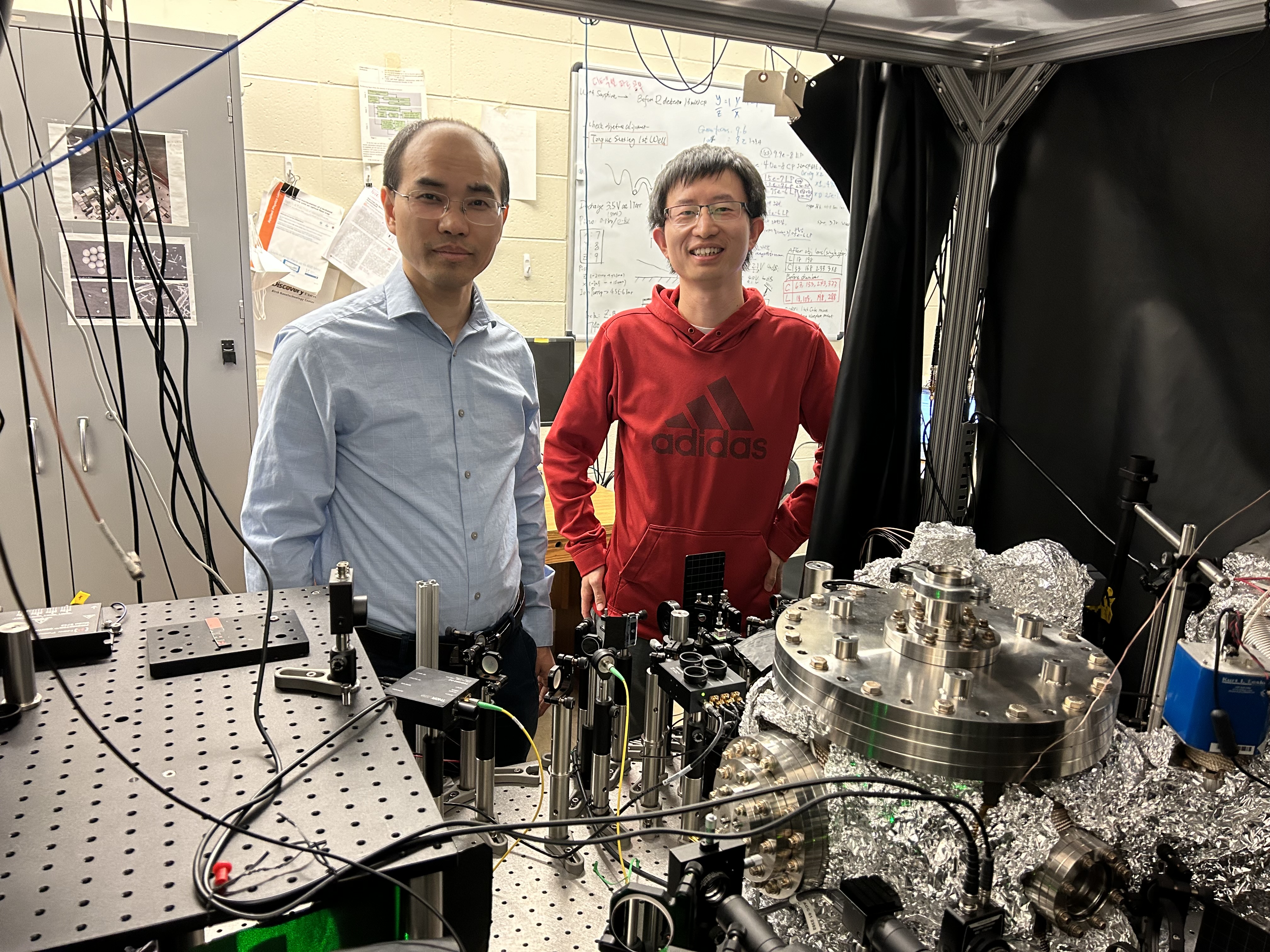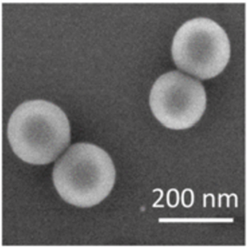Purdue physicists lift a nano-dumbbell with light and spin it at 100 billion rpm near a surface
2023-12-08
Physicists at Purdue use tweezers made of lasers to lift and spin nano-dumbbells near nanostructures in order to study gravity between nano objects

 Lifting dumbbells in a gym is much different than lifting them in a physics lab. Physicists use optical tweezers made from light to lift nano-dumbbells. A nano-dumbbell is a nano-scale dumbbell-shaped object. Pictured to the left is the particle physicists used in experiments at Purdue University to stably bring the nanoparticle near a sapphire surface with an optical tweezer.
Lifting dumbbells in a gym is much different than lifting them in a physics lab. Physicists use optical tweezers made from light to lift nano-dumbbells. A nano-dumbbell is a nano-scale dumbbell-shaped object. Pictured to the left is the particle physicists used in experiments at Purdue University to stably bring the nanoparticle near a sapphire surface with an optical tweezer.
The separation between the nanoparticle and surface is only about one one-hundredth of the average diameter of human hair. In an experiment conducted at Purdue University, physicists were then able to spin these nano-dumbbells at about 100 billion rpm! They recently published their findings in Nano Letters.
“As the nanosphere is the building element of our toolbox, the nano-dumbbell is the simplest product of nanospheres that are asymmetric. Being asymmetrical is crucial for spinning and torque detection,” explains Peng Ju, PhD student and lead author of this publication. “We use light to drive the nano-dumbbell to spin at about 100 billion rpm. The corresponding relative linear velocity is about 4 times the speed of sound at standard temperature and pressure! We also demonstrated it to be an ultrasensitive torque detector. Bringing such an ultrasensitive torque detector near the surface will enable the measurement of non-Newtonian effect and quantum vacuum fluctuation induced torque.”
Ju works in the lab of Dr. Tongcang Li, Professor of Physics and Astronomy and Electrical and Computer Engineering, who is the corresponding author for this work. The two conceived the concept and designed the project. Ju was involved in every aspect of this experiment. Lab-mates Kunhong Shen, Zhujing Xu, Xingyu Gao (all PhD students) and post-doc Yuanbin Jin helped with the experiment. Members of Penn State Electrical Engineering, Yao Duan and Xingjie Ni were also involved and helped fabricate the nanograting on a sapphire plate. Ni is a PhD 2012 alumnus of Purdue University Electrical and Computer Engineering.
“Torsion balance was used by Cavendish to precisely measure gravitational constant in 1797, and used by Coulomb to detect the electric interaction,” explains Li. “Following their work, torsion balance has been used as a highly sensitive tool to study fundamental physics still today. Our optically levitated nano-dumbbell is a torsion balance in nanoscale. We demonstrate the remarkable torque sensitivity of the nano-dumbbell in our work, and theoretically show its potential to measure non-Newtonian gravity and quantum vacuum fluctuation induced torque with unprecedented precision near nanostructures. The ability to bring the torsion balance near the surface makes it possible to study gravity between nano objects with our system, which is most exciting.”
The team uses a man-made flat sapphire crystal plate in the experiment. Synthetic sapphire is commonly used to replace glass for its special properties. The team used the sapphire plate due to its transparency and excellent thermal conductivity. The sapphire surface transfers heat so quickly that laser is unable to heat it up.
 At the left is a schematic diagram of this experiment. This diagram demonstrates the rotation of a nano dumbbell near a surface with nanostructures. An important aspect of this experiment is that such state-of-the-art torque sensing near the surface is conducted at room temperature.
At the left is a schematic diagram of this experiment. This diagram demonstrates the rotation of a nano dumbbell near a surface with nanostructures. An important aspect of this experiment is that such state-of-the-art torque sensing near the surface is conducted at room temperature.
“This is an important technical advantage of our system,” says Ju. “We can precisely measure torque at room temperature. Normally, torque sensitivity becomes better at lower temperatures. However, a system that only works at low temperature limits the general applications as low temperature means more complex setup and much more expensive. Here, our demonstrated torque sensitivity at room temperature is more than 50 times better than the nanofabricated torque sensor at millikelvin temperatures. Being able to increase the performance and reduce the cost makes our system stand out.”
Rotation, or spin, is extremely important in physics. The concepts of torque and rotation are fundamental and have wide-ranging applications in various fields. Studying the rotation and torque can enable full quantum control of the levitated nanoparticle and precision measurement of fundamental physics, such as non-Newtonian gravity and Casimir torque. Fast rotating nanoparticle near surface can potentially measure long-sought vacuum quantum friction.
“In our work, we bring nano torsion balance near its measurement target, making it possible to detect virtual photon induced torque and search for non-Newtonian gravity,” says Ju. “Searching for non-Newtonian gravity helps people better understand gravity, one of the four fundamental interactions. Studying virtual photon induced interaction is crucial for designing reliable on-chip MEMS devices.”
Ju says that work of this nature is more possible at Purdue University due to the collaborative nature of the physics department and Birck Nanotechnology Center. Both provide cutting-edge facilities that enable this type of research.
“Prof. Tongcang Li has been working on levitated optomechanics for over 10 years. Our group is among the ‘top tier’ research groups in this area,” says Ju. “Purdue has a large and active community in AMO related research.”
The team acknowledges support from the Office of Naval Research under Grant No. N00014-18-1-2371 and National Science Foundation under Grant PHY-2110591 for their work. This project is also partially supported by the Laboratory Directed Research and Development program of Sandia National Laboratories.
Related:
About the Department of Physics and Astronomy at Purdue University
Purdue Department of Physics and Astronomy has a rich and long history dating back to 1904. Our faculty and students are exploring nature at all length scales, from the subatomic to the macroscopic and everything in between. With an excellent and diverse community of faculty, postdocs, and students who are pushing new scientific frontiers, we offer a dynamic learning environment, an inclusive research community, and an engaging network of scholars.
Physics and Astronomy is one of the seven departments within the Purdue University College of Science. World-class research is performed in astrophysics, atomic and molecular optics, accelerator mass spectrometry, biophysics, condensed matter physics, quantum information science, particle and nuclear physics. Our state-of-the-art facilities are in the Physics Building, but our researchers also engage in interdisciplinary work at Discovery Park District at Purdue, particularly the Birck Nanotechnology Center and the Bindley Bioscience Center. We also participate in global research including at the Large Hadron Collider at CERN, many national laboratories (such as Argonne National Laboratory, Brookhaven National Laboratory, Fermilab, Oak Ridge National Laboratory, the Stanford Linear Accelerator, etc.), the James Webb Space Telescope, and several observatories around the world.
About Purdue University
Purdue University is a public research institution with excellence at scale. Ranked among top 10 public universities and with two colleges in the top 4 in the United States, Purdue discovers and disseminates knowledge with a quality and at a scale second to none. More than 105,000 students study at Purdue across modalities and locations, with 50,000 in person on the West Lafayette campus. Committed to affordability and accessibility, Purdue’s main campus has frozen tuition 12 years in a row. See how Purdue never stops in the persistent pursuit of the next giant leap, including its first comprehensive urban campus in Indianapolis, the new Mitchell E. Daniels, Jr. School of Business, and Purdue Computes, at https://www.purdue.edu/president/strategic-initiatives.
Contributors:
Peng Ju, PhD student at the Purdue University Department of Physics and Astronomy in the College of Science
Dr. Tongcang Li, Professor of Physics and Astronomy and Electrical and Computer Engineering
Photos and graphics provided by Tongcang Li and Peng Ju
Written by Cheryl Pierce, Communications Specialist